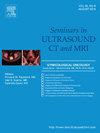眩晕和头晕的临床表现:放射科医生应该知道什么?
IF 1.9
4区 医学
Q3 RADIOLOGY, NUCLEAR MEDICINE & MEDICAL IMAGING
引用次数: 0
摘要
头晕和眩晕是急诊和门诊常见的主诉症状,需要仔细评估以确定适当的诊断和治疗。区分头晕的外周原因和中枢原因对有效治疗至关重要。前庭神经炎、良性阵发性位置性眩晕(BPPV)和梅尼埃病等外周原因与中风、脱髓鞘疾病和后窝肿瘤等中枢原因形成鲜明对比。诊断方法包括评估眼震模式、前庭眼反射(VOR)和 HINTS Plus 测试。根据病程和症状表现,前庭障碍可分为急性、发作性和慢性。当临床检查结果不确定时,影像学检查在确定中枢性病因方面发挥着重要作用。本文全面概述了头晕和眩晕的临床评估和诊断方法,重点是区分外周病因和中枢病因。本文章由计算机程序翻译,如有差异,请以英文原文为准。
Clinical Aspects of Vertigo and Dizziness: What Should the Radiologist Know?
Dizziness and vertigo are common complaints in both emergency and outpatient settings, requiring careful evaluation to determine appropriate diagnosis and treatment. Differentiating between peripheral and central causes of dizziness is crucial for effective management. Peripheral causes, such as vestibular neuritis, benign paroxysmal positional vertigo, and Ménière's disease, are contrasted with central causes such as stroke, demyelinating diseases, and posterior fossa tumors. Diagnostic approaches include assessing nystagmus patterns, the vestibulo-ocular reflex, and the HINTS Plus test. Vestibular disorders are classified as acute, episodic, or chronic based on duration and symptom presentation. Imaging plays a significant role in identifying central causes when clinical findings are inconclusive. This paper provides a comprehensive overview of the clinical evaluation and diagnostic methods for dizziness and vertigo, with emphasis on distinguishing peripheral from central etiologies.
求助全文
通过发布文献求助,成功后即可免费获取论文全文。
去求助
来源期刊
CiteScore
2.60
自引率
0.00%
发文量
49
审稿时长
6-12 weeks
期刊介绍:
Seminars in Ultrasound, CT and MRI is directed to all physicians involved in the performance and interpretation of ultrasound, computed tomography, and magnetic resonance imaging procedures. It is a timely source for the publication of new concepts and research findings directly applicable to day-to-day clinical practice. The articles describe the performance of various procedures together with the authors'' approach to problems of interpretation.

 求助内容:
求助内容: 应助结果提醒方式:
应助结果提醒方式:


